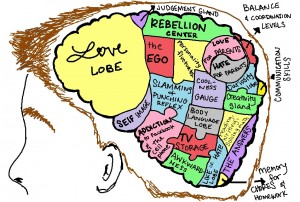For years we have blamed teens’ behavior on their “raging hormones”– which do in fact affect teens. 
With more sophisticated brain imaging, researchers now understand that underlying many notorious teen behaviors is the pace of brain development.
Knowledge is power. Here’s how you can decode and respond to the teens in your life.
What Were You Thinking?
- Developmental challenge: The brain’s pre-frontal cortex, which controls executive functions, is not fully developed until age 20.
- Implications: Adolescents have trouble planning, problem solving, and controlling impulses. Teens are more likely to take risks, like shoplifting or driving a golf cart down a steep hill.
- What can you do? Understand where kids are coming from and provide coaching and support to help them learn how to strategize, prioritize, and think things through.
Feeling Your Pain
- Developmental challenge: The amygdala, which develops in hyper-drive in adolescence, is where raw emotions such as fear and anger are generated.
- Implications: Since they lead with their emotions, they often respond with more intensity than seems warranted. (Teens also can be more spontaneous and less inhibited in ways we admire.)
- What can you do? Don’t take things personally! When that intense voice comes at you from your darling child, take a breath and speak softly to calm things down.
The Quest for Pleasure
- Developmental challenge: Located at the base of the forebrain, the nucleus accumbens is related to reward seeking.
- Implications: The brain’s relative immaturity means that teens need big jolts to feel pleasure, resulting in preferences for low effort/ high excitement activities like video games, skate boarding and, unfortunately, substance use.
That’s not all. In studies, a teen’s prefrontal cortex (remember, central to weighing risk and consequences) shows a diminished response when their reward center experiences intense excitement. It is as if the pleasure response hijacks the executive function. - What can you do? Provide experiences that are safe and highly rewarding, and understand that teens’ lack of enthusiasm at times is developmental.
Use It or Lose It
- Developmental challenge: The brain is still developing during the teen years, even into the 20s. Most surprising is that teens go through a second wave of overproduction of gray matter – as in the first 18 months of life – followed by a process of “pruning,” where unused neural connections wither away while those that are used, stay. Thus, the “use it or lose it” principle.
- Implications: Teens start to figure out how to make it in the world, as they gain new skills and knowledge and adapt to environmental demands. (This explains a 13 year-old’s ability to master new technology while parents struggle.)
- What can you do? Encourage your son or daughter to engage in meaningful, enjoyable activities that help them stretch and grow. Find opportunities like Moving Traditions’ programs, with a supportive mentor and peer community, that draw on a gender lens and Jewish values to help teens think critically about the messages they receive from the world around them.